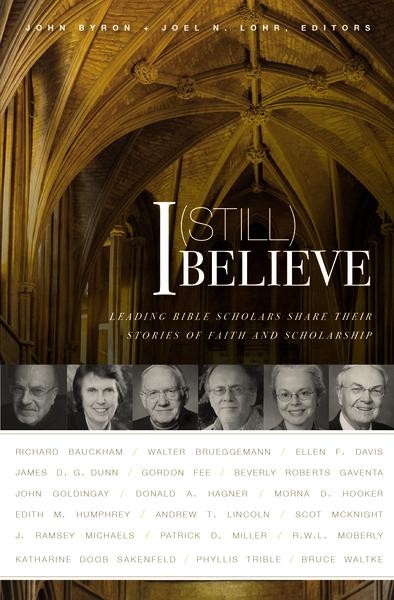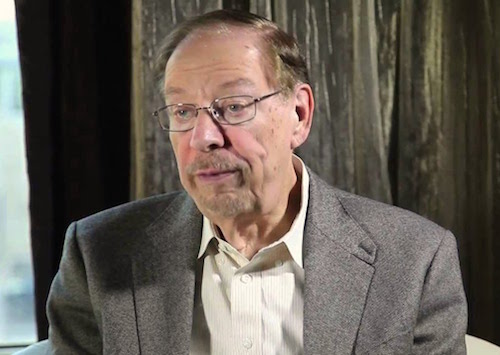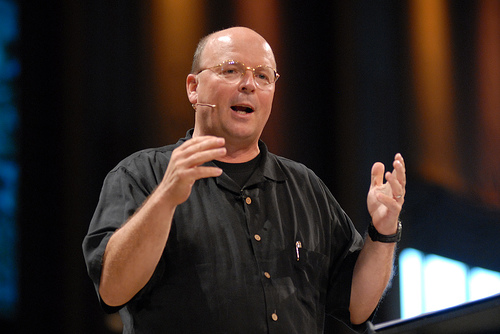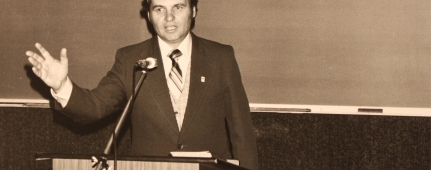Can You Reject Biblical Inerrancy and Still Be a Faithful Mentor?
A Review of the Book I (Still) Believe: Leading Bible Scholars Share Their Stories of Faith and Scholarship
F. David Farnell, PhD
“It is enough for the disciple that he become like his teacher, and the slave like his master.” (Matt. 10:25)
Mentoring Matters!
This article is not so much about methods of mentoring as it is about the consequences of mentoring. Mentoring has at its core that of training disciples for the glory of Jesus Christ. When Jesus’ pronounced the Great Commission, discipleship or mentoring was at its core (“make disciples”—Matthew 28:19-20). He commanded his followers to mentor or make disciples of all nations. The content of mentoring was to be that of His teaching (“teaching them to observe all the things that I have commanded you”—Matthew 28:20) as well as that of conforming to His Person, i.e. Jesus’ disciples were to be like Him (“It is enough for the disciple that he become like his teacher, and the slave like his master” (Matt. 10:25). The Scripture contains a promise that when Jesus returns his true disciples will be conformed to His image, “[w]e know that when He appears, we will be like Him, because we will see Him just as He is” (1 John 3:2).
Mentoring or discipleship has a special, sharp focus in the church of Jesus Christ. According to Paul, pastors and teachers are to equip the saints for ministry (Eph. 4:11-12) until we are all conformed or matured to the image of Christ:
. . . until we all attain to the unity of the faith, and of the knowledge of the Son of God, to a mature man, to the measure of the stature which belongs to the fullness of Christ. As a result, we are no longer to be children, tossed here and there by waves and carried about by every wind of doctrine, by the trickery of men, by craftiness in deceitful scheming; but speaking the truth in love, we are to grow up in all aspects into Him who is the head, even Christ (Ephesians 4:13-16).[1]
Discipleship has a primary goal of maturity in the Christian faith (1) towards Christ-likeness and (2) maturing believers in “healthy teaching” (sound or “healthy” doctrine) so that they are strengthened in their Christian beliefs (i.e. doctrine) with the result that they can withstand the onslaught of false doctrine. For Paul reminds us not only can there be “sound” or “healthy doctrine” but also “false doctrine” (“teaching strange” or “heterodox” doctrine—1 Tim. 1:3) that he also characterized as “doctrines of demons” that bring harm to Jesus’ church (1 Tim. 4:1).
Leaders Will Be Held Accountable
Peter reminds us that leaders in Christ’s church, his body, are the under-shepherds who are to disciple His flock until he returns (1 Pet. 5:1-4). Hebrews reminds all those who assume leadership positions in the church are “those who will give an account” to the Lord at judgment for their discipling of His people (Heb. 13:17). Perhaps Jesus’s half-brother James issued the most solemn warning about those who would disciple, train, mentor Jesus’ flock, “Let not many of you become teachers, my brethren, knowing that as such we will incur a stricter judgment” (James 3:1) that echoes Jesus’s words that “to whom much is given, much is required” (Luke 12:48). Particular with James is the focus upon the damage that the tongue (teaching) of the teacher can do when misused, for the source of the tongue James ascribes to “hell” (“gehenna”—James 3:6) itself when it does things that damage God’s flock as a result of bad mentoring.
Why state the obvious about mentoring? The context of Christian education, training of men and women for serving Jesus Christ, is especially where mentoring and discipleship comes to great prominence, especially among evangelicals who profess some form of faithfulness to God’s Word. Christian education can be used to strengthen God’s church or it can also become a means to damage God’s flock.
Mentoring Can Produce Disciples Twice As Much A Son Of Hell As Their Teacher!
Jesus excoriated the Pharisees of the day, for their teaching or mentoring produced a radicalizing of their teaching or doctrine among their students: “Woe to you, scribes and Pharisees, hypocrites, because you travel around on sea and land to make one proselyte; and when he becomes one, you make him twice as much a son of hell as yourselves” (Matt 23:15). Perhaps above many in Judaism, the Pharisees recognized the importance of mentoring but were neglectful of its consequences. Jesus keenly observed the students whom the Pharisees mentored and understood very well the influence that this mentoring had on their students. In short, the impact of the false teaching of the Pharisees radicalized the “next generation” of their disciples.
Nullifying the Word of God
The oral law of the Pharisees serves as a primary example. Their oral law taught that the oral word of the scribes (“doctrines of men”) had been used to nullify the Word of God, for Jesus applied Isaiah 29:13 “‘but in vain do they worship me, teaching as doctrines the precepts of men.'” This oral law (i.e., Mishnah) became so radicalized in Second Temple Judaism that the Talmud (the oral law that was eventually written down) asserted that scribes could overturn the written Word of God. The following assertions used in mentoring among these rabbinical students are merely a few surprising examples:
- It is more wicked to question the words of the rabbis than those of the Torah: “My son, be more careful in [the observance of] the words of the Scribes than in the words of the Torah, for in the laws of the Torah there are positive and negative precepts; but, as to the laws of the Scribes, whoever transgresses any of the enactments of the Scribes incurs the penalty of death”—Babylonian Talmud Mas. Eiruvin 21b
- A rabbi debates God and defeats Him. God admits the rabbi won the debate: “R. Nathan met Elijah and asked him: What did the Holy One, Blessed be He, do in that hour—He laughed [with joy], he replied, saying ‘My sons have defeated Me, My sons have defeated Me”. Mas. Baba Metzia 59b
- The prophet Isaiah was justifiably killed for stating that the Israelites had unclean lips: “When the saw reached his mouth he died [And this was his penalty] for having said, ‘And I dwell in the midst of a people of unclean lips”—Babylonian Talmud Yevamoth 49b.
- No merit in studying the Old Testament Scripture but great merit in studying the Talmud or oral rabbinical traditions: “Our rabbis taught: They who occupy themselves with the Bible (alone) are but of indifferent merit; with Mishnah, are indeed meritorious, and are rewarded for it; with Gemara—there can be nothing more meritorious. Yet always run to the Mishna more than to the Gemara.”—Babylonian Talmud Mas. Baba Metzia 33a
- Rabbis may overturn the written OT words of God (Several places throughout Talmudic literature, we are told of the principle that the Rabbis have the ability to “uproot” directives from the Torah (see Babylonian Talmud Mas. Yevamot 89b-90b).
Following In the footsteps of the Pharisees
The point here is that the Pharisees, while perhaps starting out well in their history, radicalized, departed from God’s written Word, disrespected it for their oral traditions, and then radicalized their students through their teachings, and those radicalized further radicalized others until the authority the written Word was entirely rejected. This tragic state of affairs in mentoring reveals tragic results.
Mentoring by Christians cannot absolve itself of similar tragic mistakes, for similar ideas have been advocated whereby the Word of God is overridden for the sake of traditions of men as well as philosophy (Col. 2:8). Jesus excoriated the Judaism of his day (Matt. 15: 1-9; 23:1-33) and was the greatest advocate for return to the commandments of God. For this reason, evangelicals who attempt to place Jesus under the confines of Second temple Judaism do so by invalidating Jesus’ teaching on the primacy of God’s Word and the need to avoid the traditions of men as so evidenced in the corruption of Judaism in his day.
Faithfulness to the Bible is Paramount
The New Testament writers made clear that faithfulness to New Testament teaching is paramount in mentoring. Paul wrote that faithful men are to instill faithfulness, not radicalized teaching, into their mentoring ministry of future generations: 2 Timothy 2:2—”the things which you have heard from me in the presence of many witnesses, entrust these to faithful men who will be able to teach others also” and Titus 1:9 “holding fast the faithful word which is in accordance with the teaching, so that he will be able both to exhort in sound doctrine and to refute those who contradict.”
Consistent faithfulness to God’s Word is always the goal of Christian mentoring. This stipulation is why Paul urged Christian leaders, mentors, teachings, disciplers to “preach the Word” and avoid the “strange” doctrines of men (1 Tim. 1:3), i.e. doctrine that is not plainly, normally expressed in the New Testament writers, for as John the Apostle also noted those who abide in fellowship or agreement with apostolic teaching abide in fellowship also with the Father and Son (1 John 1:3-4).
Those who leave orthodox Christianity and its teachings demonstrate their apostate position (1 John 2:19—”they went out from us, but they were not really of us; for if they had been of us, they would have remained with us; but they went out, so that it would be shown that they all are not of us”). To depart from sound doctrine or apostolic teaching is to demonstrate false discipleship (cp. Acts 20:28-31—”Be on guard” against false teachers).

John Byron and Joel N. Lohr, eds., I (Still) Believe: Leading Bible Scholars Share Their Stories of Faith and Scholarship (Grand Rapids, MI: Zondervan, 2015).
Reviewing the Book I (Still) Believe (2015)
Why this kind of introduction? A recent book by Zondervan, I (Still) Believe (2015), edited by John Byron (Professor of New Testament, Ashland Theological Seminary) and Joel N. Lohr (Dean of Religious Life and Associate Professor of Practice, University of the Pacific), serves as a timely warning about the importance of discipleship and radicalization of disciples in Christian circles.
This book speaks to mentoring and discipleship and the training of the “next generation” of preachers and teachers in the evangelical church. Evangelical churches and schools serve as primary training centers for future generations. Indeed, evangelical churches and their denominational, and non-denominational, schools are the primary foci for training the future trainers of congregations in Christian doctrine, i.e. pastors. They produce the “next generation” of Christian scholars, i.e. trainers of these pastors, who will move into these evangelical churches, train disciples, who in turn, will become the trainers in their schools and colleges for each successive generation.
The impact of mentoring is unquestionably enormous for evangelicals who set themselves forth as a “faithful” remnant among the professing church as a whole. However, what this current article and writer contends is that mentoring in evangelical circles has too many frequent examples of tragically bad mentoring that has lead to tragically bad results in the mentoring of future generations.
Focusing on Mentors who Struggle
The book is dedicated as follows: “For all who have struggled, wrestled, been discouraged, lamented, lost hope, wanted to give up, wondered if it all made sense, but still believe.” So its focus is on those who struggle about their Christian faith and its teachings. In turn, it gives the spiritual testimony of eighteen Christian scholars who have mentored countless others in their Christian faith but who have faced their own doubts about the Old and New Testament.
The book’s editors, correctly recognizes the importance of mentorship, “Like many students, our professors made quite an impression on us” (p. 11) “When we became graduate students the relationships grew deeper, and their influence only intensified” (p. 11) Thus, evangelical churches and schools have enormous influence on the spiritual state of God’s people through the mentors that disciple future generations, as is evidenced in all eighteen of these testimonies in the book.
The editors decided to put together in this work “a book of professors’ autobiographies” (p. 11). “We loved and admired our professors and wanted to learn more about them” (p. 11). “We wanted to learn about their struggle, their pains, their sorrows, but also their joys, reasons for hope, and what brought them fulfillment in life” (p. 11) They go on to note something very strategic as their plans developed and the importance of the mentors in their training,
The more we talked about possible themes the more that faith and scholarship came to the fore . . . we found ourselves talking again and again about how our own work as scholars of biblical literature affected our lives as people of faith . . . we couldn’t help but be reminded that our lives in the church and as people of faith did affect our scholarship . . . given that we regularly encountered stories in popular books and other media of prominent Bible scholars who left the faith as a result of their scholarship, and personally knew others who journeyed similar paths, away from faith, was their more to this story? (p. 12).
The editors decided to form a collection of “life stories by a diverse group of prominent—indeed some of the most influential and popular—Bible scholars.” (p. 12). They continue, “All of them [i.e., the featured scholars’ life stories] explore how faith and biblical scholarship intersect, each in their own way. All of them engage with the every-important question of how serious study of the Bible affects, whether to threaten or enhance (or both), one’s faith” (p. 13).
Importantly, therefore, the book reveals the impact and importance that these mentors have had upon the live of other students and how these featured mentors were influenced by their own education and mentors that mentored them, i.e. “[o]ne area in which it seems our contributors are almost completely unanimous was in their indebtedness to their own professors, teachers in whose footsteps they followed” (p. 14).
The goal of the editors compilation of these “testimonies” (p. 16) is stated as to strengthen other mentors, “[t]he essays you are about to read have strengthened our walks and blessed our way. We hope they strengthen and bless you too” (p. 16). They above all, “hope this collections brings glory and honor to the One who lives and reigns with God the Father” (p. 16).
This Writer was Not Blessed
In evaluating this work, the present writer was not strengthened in his faith or blessed. To put it bluntly, many of the scholars featured revealed a shocking departure from a faithful teaching of God’s Word. What is revealed, perhaps inadvertently in this work, is how far afield many who train our future generations have gone from teaching trust and confidence in God’s Word, and instead, have sown seeds of doubt and uncertainty in the future generations that God has placed under their sphere of influence. Instead of faithfulness, a strong tendency to the exaltation of scholarship over the Lordship of God and His Word is shown to be pervasive in some of these testimonies.
Raising Up Great Doubt
Many of these evangelical mentors were mentored or influenced by others who were either completely unbelievers in secular university who raise up great doubt in them through their instruction under them or by other evangelicals who were experiencing great crisis of doubt themselves. These influences were then passed on to others sitting in evangelical churches, colleges and seminaries. While perhaps not all these testimonies contained in the book were entirely negative in the impact of mentoring, a significant portion of these testimonies leave the reader with the startling conclusion that evangelicals are in trouble not merely because of the influence of the world from the outside but also because of an infiltration of a negative influence in mentoring in the church from within.
Examples of Raising Doubt
Due to space limitations, four examples must suffice. The readers of this review are encouraged to examine the other testimonies in the work. One must note that this article is in no way questioning the renowned scholarship of those being reviewed, but what is being questioned is the startlingly negative potential impact of what they teach (content of the teaching) to those who were influenced by them under their ministry in the church or classroom as disciples (future pastors and educators) of God’s people, especially as centering on the how they influenced minds regarding the trustworthiness and integrity of God’s Word. The point being driven home in this review is that mentoring among evangelicals is crucial and that mentoring is not being examined carefully or closely by evangelicals as a whole.

Donald A. Hagner is currently Emeritus Professor of NT at Fuller Theological Seminary
Example #1: Donald Hagner—Historical Criticism and the Wondrous Freedom from Any Ideas of the Inerrancy of God’s Word
Hagner’s testimony brings into sharp focus the current state of mentoring at many evangelical seminaries. Although he attended a variety of Lutheran and “fundamentalist” churches in his youth, Hagner relates that “philosophy could be dangerous to your faith,” so that by his junior year at Northwestern University, on a music scholarship, “I was calling myself an agnostic” . . . . “My faith was easily demolished. I was in fact defenseless . . . . I was a lapsed Christian” (pp. 106-07). Fortunately, a Christian reached out to Hagner and “I began to reconsider Christianity” so that “At the end of my four year stint in the band I was back on tract and decided to go to seminary” (p. 107).
He enrolled at Covenant Seminary, but he found it “academically rather disappointing” (p. 107, emphasis added). Why? He relates the reason, “There was no encouragement of critical thinking” (p. 107, emphasis added) and “the seminary seemed to reflect a fortress mentality.” Perhaps, however, the following quote, clearly expresses the mentoring that Hagner provided to his students (and readers): “The seminary’s [Covenant] stance on inerrancy had a paralyzing effect when it came to biblical scholarship. Serious work with the text had to yield to forced harmonization.” (p. 107, emphasis added). Instead, Hagner found a blessing in “critical approaches to the Bible, which can be intrinsically risky to the believer” (p. 108). He believes that these critical approaches can be “purged from its unjustifiable presuppositions” and “no ultimate threat to the believer.” (p. 108).
In terms of inspiration, Hagner maintains that “conservatives” “welcome criticism [of Scripture] and be willing to join in it” (p. 108). For Hagner, “[t]hat the Bible claims inspiration is patent. The problem is to determine the nature of that inspiration in light of the phenomena therein.” He outright rejects the deductive approach to inspiration that would assert that “the Bible is the word of God; God does not lie, therefore there are no ‘errors’ in the Bible” (p. 108-09), since such a criteria “results often in the imposing our own criteria upon the Scripture (a particular level of exactness of detail in chronological numbers, Synoptic agreement, and so forth) that may have been no concern to the original authors.”
He admits, however, that because of the “critical method” that he favors “many, including friends of mine, have lost their faith when they encountered critical thinking from their professors” (p 109, emphasis added). However, Hagner especially blames “fundamentalist contexts” for loss of faith instead: “Some who have lost their faith through their studies are often driven away from believing by fundamentalist contexts which allowed them no alternative between, on the one hand, a closed-minded, clench-fisted, fear-ridden mentality and, on the other, outright unbelief, whether agnostic or atheistic” (p. 109).
Apparently, Hagner believes in a “goldilocks” position of some kind of partial belief in Scripture. He praises Fuller Theological Seminary where he taught for so many years, for dropping in 1972 the language in the doctrinal commitment of “‘free from error in the whole and in part’ from its description of Scripture.” (p. 109). He prefers the idea that Scripture is a “trustworthy record,” “given by divine inspiration,” and is “the only infallible rule of faith and practice.” (p. 109-10). He rejects the term “inerrancy” because it functions as a “shibboleth” that in his mind has little apparent meaning, i.e. the word “‘inerrancy’ is difficult to define.” He does not find the word “inerrant” as “helpful” in describing Scripture. Instead, he accepts that inerrancy would only be applied to intention of the author, “I accepted inerrancy only in terms of the intention of the authors, and not as determined by criteria external to the text itself” (p. 110). He especially reacts to Harold Lindsell, also a Fuller professor, whose view of inerrancy he describes as “flat-footed, literalistic interpretation that refuses to face the reality of Scripture as God has given it to us” (p. 110). He especially criticizes Lindsell for not recognizing the Scripture as “the words of human beings” (p. 110). Instead, Hagner likes “open inerrancy” as a term that apparently allows for errors in the Bible as “breathing room for the scholar to deal with the actual phenomena . . . in the Scripture” (p. 111).
Yet, Hagner ironically has a patent ignorance of the Chicago Statement on Inerrancy (p. 111). He erroneously ascribes to the Chicago Statement as agreeing with his position by citing ICBI Article XIII, “We deny that it is proper to evaluate Scripture according to standards of truth and error that are alien to its original purpose.” However, R. C. Sproul, a founding member of ICBI on inerrancy, noted regarding the committee’s formulation of this article the exact opposite intent of Hagner’s application,
“By biblical standards of truth and error is meant the view used both in the Bible and in everyday life, viz., a correspondence view of truth. This part of the article is directed toward those who would redefine truth to relate merely to redemptive intent, the purely personal or the like, rather than to mean that which corresponds with reality. For example, when Jesus affirmed that Jonah was in ‘the belly of the great fish’ this statement is true, not simply because of the redemptive significance the story of Jonah has, but also because it is literally and historically true. The same may be said of the New Testament assertions about Adam, Moses, David and other Old Testament persons as well as about Old Testament events.” (ICBI, Commentary, Sproul, p. 50).
The correspondence view of truth that is anchored to this statement would immediately rule out the kind of biblical interpretation or “historical criticism” that Hagner advocates, for it affirms the plain, normal sense of Scripture as the meaning of the passage by referencing the “correspondence view of truth,” i.e. the Bible.
In contrast, using historical-critical ideology, Hagner maintains that in his Word commentary on Matthew (Matthew 1-13, Waco, Word Biblical Commentary, 33a) regarding the Infancy Narratives, he “decided not to defend the historicity of each event and each detail of each event” (p. 112). Instead, he “took as a beginning presupposition that every periscope has a historical core that was transmitted carefully, but also worked with creatively by the evangelist,” preferring Birger Gerhadsson’s approach who mentored Hagner during a sabbatical wherein was advocated “a middle way between belief in inerrant documents immune from critical judgment and the skepticism of more radical criticism (see Gerhardsson, The Reliability of the Gospel Tradition, 86-87).
Hagner asserts that “I discovered further that my faith in the basic reliability of the Gospels is not undermined if, in a few rare instances, I may suspect the actual historicity of a report” (p. 112, emphasis added). For Hagner, such assertions as the resurrection of the Saints in Matthew 27:51-54 was not an actual, historical event: “I could not convince myself that the narrative of the resurrected saints who walked into Jerusalem and were seen by many (27:51-54) was an actual occurrence. (p. 112). Hagner asserts that the resurrection of saints at Jesus’s death did not occur historically. For Hagner, the earliest Christians interpreted the open tombs, that were really caused by an earthquake, mistakenly as resurrection “In my opinion the evangelist was handing down a piece of tradition that originated with the earthquake that took place at the death of Jesus. It was the sight of open tombs that made the Christians think of resurrection, anticipating the imminent resurrection of Jesus, that produced this theologically [BUT not historically] correct story” (p. 112-13). Yet, one wonders about Hagner’s logic here since he believes the early Christians were mistaken about the resurrection of the saints, what stops this kind of logic from being applied to Jesus’s resurrection in that the earliest Christians mistook the rolled away stone for the resurrection of Jesus and that his alleged appearances were figments of imagination like he contends for the saints who appeared to many.
Hagner also believes that Jesus’s disciples also misunderstood and misapplied the “imminence sayings” in Matthew. He argues, “As I tried to make sense of the various eschatological sayings in Matthew, only one answer seemed to make all the data understandable. The imminence sayings concerning the coming of the Son of Man (10:23; 16:28; 24:34) all refer to the fall of Jerusalem, but because the disciples could not separate the destruction of the temple from the coming of the end of the age (see 24:3), the imminence because attached also to the end of the age. May not the disciples be excused for being a little confused on eschatology (as in Acts 1:6-7)” (p. 113).
One is left wondering with Hagner’s historical-critical approach, where this “confusion” beings and ends, leaving one absolutely confused as to what to trust about their understanding of future events in other portions of the New Testament and not merely here, i.e. Hagner’s logic cannot be limited to a few instances of his choosing! Hagner insists, however, that
“these conclusions do not undermine my strong conviction concerning the overall [emphasis added, not in the original] reliability and inspiration of the Gospels nor of the truth of Christianity. Grant me a historical core, and I can be content with approximations and interpretations. I do not need the ipsissima verba, the precise word of Jesus . . . it is sufficient to have the ipsissima vox, a re-expression of what he said, and even in highly interpreted form . . . under the inspiration of writers and their circle. Truthful narratives are possible without exact words or exactly accurate accounts” (p. 113). [2]
Thus, for Hagner, his view of inspiration allows for discrepancies and errors due to human involvement in their composition because “God . . . was pleased to give us Scripture via the words of human authors” (p. 113).
Moreover, Hagner affirms that the Chicago Statements advocated “historical-grammatical” criticism of the Bible that affirms the plain, normal sense of Scripture rather than Hagner’s “historical-critical” approach: On the contrary, both the correspondence view of truth and the historical-grammatical view of interpretation demand that the doctrine of inerrancy as embraced by ICBI is claiming that the belief in biblical inerrancy entails actual truths about reality (ICBI, Commentary, 11).
In spite of these negations of the historicity or factuality of the Gospel content and his being mentored by more liberal-leaning Tübingen scholars like Hengel, Hofius and Stuhlmacher during a sabbatical, Hagner was “won over” to these professors “scholarship and faith” due to the “convincing power and plausibility of their credible work, their reverence for Scripture, and their confidence that scholarship that was superior to that of liberals vindicated the faith of their church” (p. 113). One is left wondering about Hagner’s assertions here; specifically one is left with the impression that in Hagner’s way of thinking anyone who fully trusted the Scripture in its content, as the three-hundred theologians ICBI theologians did, would not be true scholars in Hagner’s assessment. They would be considered more naïve simpletons who failed to appreciate the superior critical judgment of historical-critics.
He alleges that “[p]ractioners of the critical method should therefore be prime models of humility” (p. 114). The reader of his article, however, is not given that impression of Hagner’s assessment of himself since a very strong underlying tone is his hubris in being a judge of Scripture; a final arbiter of what can and cannot be accepted in Scripture as to its truthworthiness, integrity, historicity and meaning. Hagner presides as judge, i.e. “lord” over Scripture, rather than allowing Scripture to stand as judge in its plain, normal sense over the actions of Hagner’s interpretive ploys. This arrogance is demonstrated when Hagner affirms, with George Ladd, the impossibility of any certainty in knowledge of the contents of Bible (“authority of the Bible as the Word of God is not dependent upon infallible certainty in all matters of history and criticism”—p. 114-15 cp. Ladd, The New Testament and Criticism, 17). Apparently, for Hagner and Ladd, God’s communication of truth has the limitations of doubt and uncertainty that cannot be overridden due to the human content of the work. Hagner continues to note that “I have . . . had doubts about the truth of Christianity now and then . . . [w]hen I have been tempted to doubt the truth of Christianity I have discovered that I really cannot” (p. 115). Apparently, for Hagner some type of personal, existential affirmation, in spite of his historical-critical approach to negating portions of Scripture compel his belief that Christianity is true, for he confesses that his confidence lies in his “historical reasoning . . . [but] it does not amount to absolute proof [since] nothing can be proved absolutely” (p. 115). Apparently, this lack of certainty applies to Scripture for Hagner.
In sum, what has disciples who learned under Hagner’s mentorship come to learn about Scripture? They are seeded in thought with a profound sense of doubt and uncertainty in God’s Word but also profound sense of the certainty of historical-criticism to evaluate the Bible.

Bruce Waltke is currently Distinguished Professor Emeritus Of Old Testament at Knox Theological Seminary
Example #2: Bruce Waltke—Historical Criticism of Sources and Scientism of Evolution Override the Plain, Normal Meaning
Another scholar addressed in the work is Bruce K. Waltke. Waltke affirms, “[m]y faith in the inerrancy of Scripture as to its Source and its infallibility as to its authority for faith and practice was firmly rooted in my formative years” (p. 237). This is well and good. Please notice, however, that Waltke appears to limit inerrancy/infallibility to “faith and practice.” Although a Christian at a very young age due to the influence of his mother, he reveals that his college years were filled with doubt and uncertainty while studying history and philosophy (e.g., Voltaire and Rousseau). While he overcame his crisis of faith, he still continued with “doubt about my inherited high view of the Bible’s inspiration” (p. 239). For him, such uncertainty was “fueled by the Bible’s apparent contradictions; by its numerous textual variants in ancient Hebrew manuscripts and versions of the Bible; by questions of higher criticism . . . and by the fossil record, which calls into question the historical reliability of Genesis 1” (p. 239-40).
In terms of Bible discrepancies, he believes that “most” “but “not all” can be eliminated (p. 242). Attending Harvard, however, for his doctorate, he confronted “intellectual problems to my faith” (p. 243). He notes, “Harvard emphasized their similarity [between the OT and ancient Near Eastern literatures], and this similarity makes the Bible appear to be a very human—not a divinely inspired—book. The cosmology of Genesis 1 is similar to pagan cosmologies of the biblical Word; Moses’ book of the covenant at some points repeats word-for-word the Code of Hamurabi; the war annals of the historical book resemble those of the pagans; David’s psalms are similar to Sumerian, Akkadian, and Canaanite hymns . . . ” (p. 243-44).
The good news is that Waltke believes his faith was still intact. He praises his “Harvard professors, who accepted me graciously and honed me into a scholar” (p. 245). Yet their influence upon him was apparently profound. He now believes in a form of documentary hypothesis rather than Mosaic, eyewitness authorship. He admits that now he does not hold to the Mosaic authorship of the Pentateuch, “[d]uring my career I rethought the authorship of the Pentateuch. Changes in the divine name . . . of vocabulary and style . . . of theological perspective strongly argue that the Pentateuch is composed of at least three sources documents” [i.e. J, P, D]. Thus, he adopts the idea that [t]he scientific evidence that the Pentateuch is composed of documents is compelling” (p. 247). He also believes that Deuteronomy’s “canonical form” is “a post-exilic work that recounts the history of Moses’ writing the book of the law. He sums up that “I accept the documentary hypothesis, but I do not accept the documentary hypothesis of Wellhausen” (p. 247). Moreover, he believes that the book of Isaiah had at least two authors, “conservative response [to multiple Isaiah authorship] has been overreactionary” (p. 247) and “as Jesus blends Elijah with John the Baptist, the book of Isaiah blends Isaiah with his disciple” (p. 247).
He sums up his position by affirming “I am not a Fundamentalist, who stands upon the Word of God convinced that the preconceived interpretations of my tradition are right or that my interpretations are inerrant” (p. 247-48). As such, he regards the early chapters of Genesis “as recounting real history in the garb of the ancient Near Eastern mythological imagery, and so interpret the fossil record with mainstream science. I believe that theistic evolution is a possible synthesis of Scripture and science, but I do not believe in theistic evolution” (p. 248). One wonders, however, where Genesis as “Near Eastern mythological imagery” as Waltke asserts, begins and ends as myth, i.e. what can be truly understood as historical in the account at all.
He concludes that “I hope that those who plan on an academic career in biblical studies will find these reflections on apologetics and biblical criticism helpful to their faith in the Bible’s inspiration and authority” (p. 249). Oddly, how could a student being mentored under Waltke’s approach in thinking ever being strengthened in faith? Waltke has called into question large parts of the Old Testament in terms of historicity, factuality and authorship. Prophecy as supernatural has been discounted in seeing two Isaiahs. The student under his mentorship would most likely be filled with doubts about the assuredness of God’s Word. His education has enlightened him to place the burden on proof on Scripture, i.e. doubt.

James D.G. Dunn is Emeritus Professor of Divinity at Durham University
Example #3: Jimmy Dunn—Searching for Jesus with Doubt and Uncertainty as Prime Virtues Directed Against God’s Word
Another mentor featured is that of James D. G. Dunn, who titles his testimony as “In Quest of Truth” (p. 55). Dunn was mentored by C. F. D. Moule at Cambridge as well as Tyndale House (p.57). While he began under a conservative bent as “one of the leaders of a conservative evangelical faction” in Glascow and Trinity College, Dunn relates that “probing questions below the surface of faith began to predominate” (p. 57). An “international group of evangelical New Testament postgraduates who came together in Cambridge a that time began to hold regular meetings to explore how their historical and theological explanations were affecting their overview of Scripture” (p. 57). Dunn began to break “a previous unwillingness to question the infallibility of the Bible” through his doubts about the authorship of 2 Peter as not being written by the historical apostle (p. 57). He decided that such questions did not set him on a “slippery slope, down to which you would slide unavoidably into unbelief” (p. 57). He also prided himself on being able to distinguish “things that really mattered from those which mattered less or not much at all” (p. 57). Further, he asserts that “one could see Scripture though which God speaks without making that dependent on Scripture as infallible” (p. 57). He no longer made his faith “depend on minor matters of detail . . . [when] could already see clearly, was likely to prove disastrous when some detail proved to be questionable” (p. 58). He kept the focus of faith on “the primary points in biblical passages . . . and fellowship could extend across a wide range of faith tradition” (p. 58). He does not specify the criteria by which he would determine “primary points” from minor ones in the biblical data or what the cumulative impact of increasingly numerous “minor” points would do to his conceptions of trust in God’s Word.
His research in publishing lead him to “turn to explore what was primary and what was secondary in the Christian faith” (p. 60). He appreciated his discussion groups that he had experienced at Cambridge where “we could be totally honest—not least about doubts, questions, and failures—and still be fully accepted” (p. 60). He “came to the conclusion of the centrality of Christ (one might say the sole centrality of Christ) for the Christian faith and the beginnings of Christianity . . . .how the doctrine of the incarnation came about” (p. 61). He insists “that one should read the New Testament’s Christological statements without using the spectacles of later church doctrine, but also that the relevant New Testament passages were not already fixed in meaning, but were expressing the developing understanding of first Christians” (p. 61). For Dunn, “[h]olding together the man Jesus and the Christ of God has never been easy!” (p. 61).
At his tenure at the University of Durham, Dunn became a strong advocate for the New Perspective on Paul wherein he went against the Reformation perspective, arguing that danger existed in the Reformation position since Paul was “much more positive” “on the Judaism of his upbringing” than was the Reformation position of anti-Judaism” (63 cp. also a sharp critique of the New Perspective on Paul by Dunn et al. by F. David Farnell, “The Problem of Philosophy in New Testament Studies, The New Perspective On Paul “Searching For The ‘Historical Paul’,” in The Jesus Quest (pp. 86-142).
He relates also that “[w]ith my personal evangelical history, the issue of the authority of Scripture was never far from me, from my more conservative days in Glasgow through the deepening of insight and discussion in Cambridge and thereafter” (p. 63). Dunn came to the position that “Christian fundamentalism” displayed “narrowness” (p. 64). In turn, he began to engage in advocating a third “search” for what is now termed the “historical Jesus” (p. 66).
One work that he engaged in deserves special attention, that he titled Jesus Remembered (Eerdmans, 2003). To this present writer, it is this book that clearly delineates Dunn’s departure from his alleged label as a leader of “a conservative evangelical faction” (p. 57). In Dunn’s work, Jesus Remembered (2003), he states that third questers consider the neglect of the “Jewishness of Jesus” as “the most blatant disregard of history in the quest.”[3] The following analysis is derived from this reviewer’s analysis of evangelical questing in The Jesus Quest The Danger from within, pp. 392-395).
For Dunn, those who seek knowledge of Jesus’s life at best can hope for “probability, not certainty” when examining the Gospel accounts. He makes his own critical distinction between event, data, and fact in the formulation of historical events in the canonical Gospels,
All the historian has available are the “data” which have come down through history—personal diaries, reminiscences of eyewitnesses, reports constructed from people who were present, perhaps some archaeological artifacts, as well as circumstantial data about climate, commercial practice, and laws of the time . . . . From these the historian attempts to reconstruct “facts.” The facts are not to be identified as data; they are always an interpretation [italics in original] of the data. Nor should the fact be identified with the event itself, though it will always be in some degree of approximation to the event. Where the data are abundant and consistent, the responsible historian may be confident of achieving a reasonably close approximation. Where they are much more fragmentary and often inconsistent, confidence in achieving a closes approximation is bound to be much less. It is for this reason that the critical scholar learns to make carefully graded judgments which reflect the quality of the data—almost certain (never simply “certain”), very probable, probable, likely, possible, and so on. In historical scholarship the judgment “probable” is a very positive verdict. And given that more data always emerge—in ancient history, a new inscription or, prize of prizes, a new cache of scrolls or documents—any judgment will have to be provisional, always subject to the revision necessitated by new evidence or by new ways of evaluating the old evidence.[4]
For Dunn, “‘facts’ properly speaking are always and never more than interpretations of the data. . . . The Gospel accounts are themselves such data or, if you like hard facts. But the events to which the Gospels refer are not themselves ‘hard facts’; they are facts only in the sense that we interpret the text, together with such other data as we have, to reach a conclusion regarding the events as best we are able.”[5] Dunn defines the Gospel “facts” as “interpretations of the data” regarding the events to which they refer. They do not have certainty since they are mediated through the evangelists’ interpretation of those events and “The possibility that later faith has in some degree covered over the historical actuality cannot be dismissed as out of the question.” The consequence of his thinking is that “historical methodology can only produce probabilities, the probability that some event took place in such circumstances being greater or smaller, depending on the quality of the data and the perspective of the historical enquirer.”[6]
At best, to Dunn, the Gospels may give probabilities, but certainty is not a factor in historiography. In references to miracles, Dunn relates,
It was the Enlightenment assumption that necessary truths of reason are like mathematical axioms, and that what is in view is the certain QED of mathematical proof that has skewed the whole question. But faith moves in a totally different realm from mathematics. The language of faith uses words like “confidence” and “assurance” rather than “certainty.” Faith deals in trust, not in mathematical calculations, nor in a “science” which methodologically doubts everything which can be doubted. Nor is it to be defined simply as “assent to propositions as true” (Newman). Walking “by faith” is different from walking “by sight” (2 Cor. 5:7). Faith is commitment, not just conviction.[7]
To Dunn, “it is the ‘lust for certainty’ which leads to fundamentalism’s absolutizing of its own faith claims and dismissal of others.”[8] In chastising evangelicals for their greater certainty regarding the Gospels and their supernatural elements, he relates that only probability—not certainty—is the stinging “nettle” that evangelical Christians must grasp, qualifying his remark by noting that “genuinely critical historical inquiry is necessary if we are to get as close to the historical as possible. Critical [italics in original] here, and this is the point, should not be taken to mean negatively critical, hermeneutical suspicion, or dismissal of any material that has overtones of Easter faith. It means, more straightforwardly, a careful scrutiny of all the relevant data to gain as accurate or as historically responsible a picture as possible.”[9] Dunn notes “[i]n a day when evangelical, and even Christian [italics in original], is often identified with a strongly right-wing, conservative and even fundamentalist attitude toward the Bible, it is important that responsible evangelical scholars defend and advocate such critical historical inquiry.”[10] In this way, for Dunn, the term “evangelical (not to mention Christian) can again become a label that men and women of integrity and good will can respect and hope to learn from more than most seem to do today.”[11] Apparently, anyone who holds to certainty regarding such miracles as Christ’s resurrection moves into this criticism by Dunn.
As to the greatest event in the Gospels, the resurrection of Jesus (Acts 1:3), Dunn, comparing the Passion accounts in the Gospels to that of Second Temple Judaism’s literature, relates that Jesus’ hope for resurrection reflected more of the ideas of Second Temple Judaism’s concept of vindication hope of a general and final resurrection: “The probability remains, however, that any hope of resurrection entertained by Jesus himself was hope to share in the final resurrection.”[12] For Dunn, Jesus had in mind that “His death would introduce the final climactic period, to be followed shortly (‘after three days’?) by the general resurrection, the implementation of the new covenant, and the coming of the kingdom.”[13] Yet, even to speculate this much on the resurrection, he turns negative: “To be even able to say as much is to say more than historical questers have usually allowed.”[14] For Dunn, any proof of Jesus’ resurrection centers in the “impact made by Jesus as it impressed itself into the tradition.” This “impact summarized in the word ‘resurrection’ . . . requires us to concede that there was a something which happened ‘on the third day’ which could only be apprehended/conceptualized as ‘resurrection.'”[15] Dunn summarizes his thinking on data and facts regarding the resurrection:
[T]he resurrection certainly cannot be numbered among the data which have come down to us. Nor can we speak of empty tomb and resurrection appearances as data. The data are reports [italics in original] of empty tomb and of seeing/visions of Jesus. If historical facts are interpretations [italics in original] of the data, then the historical facts in this case, properly speaking, are at best the fact of the empty tomb, and the fact that disciples saw Jesus. The conclusion, “Jesus has been raised from the dead,” is further interpretation, an interpretation of interpreted data, an interpretation of the facts. The resurrection of Jesus, in other words, is at best a second order “fact,” not a first order “fact”—an interpretation of an interpretation.[16]
Dunn’s thinking here reflects the skepticism of Hume as well as Kant, having praised the former by stating, “As David Hume had earlier pointed out, it is more probable that the account of a miracle is an untrue account than the miracle recounted actually took place.”[17] Therefore Jesus being raised from the dead was possibly just an interpretation by the first disciples. For Dunn, this is why the resurrection of Jesus is so “problematic” for the twenty-first century quester:
[T]he conclusion that “God has raised Jesus from the dead,” as a conclusion of the quest, is a further act of interpretation—again, an interpretation (evaluation) of the first-century interpretation (evaluation) of the first-century interpretation . . . that departure from this life (death) can be described as a historical event, whereas entry on to some further existence can hardly be so described—it can be seen just how problematic it is to speak of the resurrection of Jesus as historical.[18]
Dunn also describes the term “resurrection” as a “metaphor” wherein he says that “the power of a metaphor is the power ‘to describe a reality inaccessible to direct description’ (Ricoeur), ‘reality depicting without pretending to be directly descriptive’ (Martin Soskice).” Thus in Dunn’s thinking it defines an undefinable something—”something which could not otherwise be said” [italics in original]. Furthermore, “to translate ‘resurrection’ into something more ‘literal’ is not to translate it but to abandon it.” Finally, he notes,
Christians have continued to affirm the resurrection of Jesus, as I do, not because they know what it means. Rather, they do so because, like the affirmation of Jesus as God’s Son, “the resurrection of Jesus” has proved the most satisfying and enduring of a variety of options, all of them inadequate in one degree or other as human speech, to sum up the impact made by Jesus, the Christian perception of his significance . . . In short, the “resurrection of Jesus” is not so much a criterion of faith as a paradigm for hope.[19]
If one applied this same logic to Dunn’s writing, then the data of his writing are merely interpreted facts of what Dunn certainly intended to express, and therefore, no one can be certain as to what Dunn meant except that what he says is a metaphor for what he meant because it is beyond anyone’s true comprehension to discern the intentions only understood by Dunn himself. Thus Dunn offers us, as he did with Paul, “a new perspective on the Jesus tradition.”[20]

Scot McKnight is currently Professor of New Testament at Northern Seminary
Example #4: Scot McKnight—Scholarship Reigns Over Lordship and the Inerrancy of Scripture
One other example of scholar mentioned in this sampling from I (Still) Believe who mentored students is that of Scot McKnight. Being associated in his youth with a baptistic background (“[m]y father was a deacon at First Baptist Church), McKnight relates that “as a child I was saved one night kneeling at a chair with my mother and father” (p. 160). He later would experience what he termed a “rededicated” life because of a “backslidden” condition (p. 161). After rededicating his life, he “was given a voracious desire to study and know the Bible, to comprehend theology, and to become a teacher someday” (p. 161). McKnight admits, however, that “[I]n my junior and senior year I became embittered about fundamentalism, and the leading impulse was the work of Francis Schaeffer. Ironically, Francis Schaeffer was a fundamentalist but was also critical of the shallowness of the American evangelical church. At that time I had not known the difference between an evangelical and a fundamentalist but a summer missionary experience in Austria with reading people like John Stott led me to see that I was an evangelical and no longer a fundamentalist. I became critical of fundamentalism enough that there were times when I was no longer sure what I believed. Seminary and later doctoral studies helped me sort out my faith” (p. 162-63). He attended Trinity Evangelical Divinity School where he came under the influence of such mentors as Murray Harris, Douglas Moo and Grant Osborne, to name only a few. He notes that “[i]t was at Trinity, under the tutelage of Walter Liefield and Grant Osborne, that I fell in love with Jesus and it was during that time my faith was formed christocentrically. Prior to that time my faith was fundamentalistic, systematic, and reactive. During those days I found what needs to be at the center of Christian faith: God in Christ.”
Nottingham University accepted him as a doctoral student where James D. G. Dunn: “admitted me and became both a wonderful mentor to my research and now a friend (even if he will always be my Doktorvater)” (p. 164). Later he would replace Wayne Grudem at Trinity as a New Testament professor (p. 165). He now teaches at Northern Seminary (p. 166).
He admits that “[f]irst as a college student, but then even more in my seminary education and especially in my doctoral studies, minute comparison of the Synoptic Gospels shook what I had been taught about the doctrine of Scripture” (p. 167). He notes that he now believes that the OT and NT is “not one self-contained text added to the previous but one text interacting—sometimes agreeing, sometimes even disagreeing, but often expanding and adjusting and renewing the previous texts. God’s inspiration then is at work in a history and a community expressed by an author for a given moment” (p. 167, emphasis added). He continues that, [t]his experience of underlining the Synoptics one word and one line after another led me to think that the words like “inerrancy” are inadequate descriptions of what is going on in the Bible. I have for a long time preferred the word “true” or “truth.” The Bible is God’s true and living Word is far more in line with the realities of the Bible itself than the political term that have arisen among evangelicals in the twentieth century” (p. 167-68). As a result, he joined into the third search for the “historical Jesus” but has now rejected it because “historical Jesus studies yields limited conclusions . . . . I can prove that Jesus died but I can never prove that he died for my sins; I can prove that Jesus asserted that he would be raised from the dead but I can never prove he rose for my justification; the historical method can only do so much” (p. 168). He asserts that the church “does not need historical Jesus studies” (p. 168). Also, he relates that “I have come to the conclusion that the Gospels are the church’s portrait of Jesus, and that portrait is what the church needs most” (p. 168). He considers Jimmy Dunn’s Jesus‘ Remembered as a very good example of good research.
He concludes that in his experience, “many former believers walk away more often [from the Christian faith] because of superficial theology of Scripture they are taught in conservative circles. Or because they have combined that kind of Scripture theory with a sudden encounter with the science of evolution . . . but when someone is reared in the faith to think it is all or nothing and that Genesis 1-3 describe the world about 6,000 or 10,000 or 20,000 years ago and they suddenly learn that the universe is 14.5 billion years old and that our DNA emerges out of hominid ancestors way more than even 20,000 their entire faith can be turned inside out.” And again, “I am grateful that I learned about science from some theologians who did not diminish science, as it often is in some conservative circles, but who slowly and patiently worked out theology in conversation with science” (p. 170).
When he is often asked to address Christians who are losing their faith, he tries is to “distance their faith from what they have learned, from the theology that they have embraced, and to try to get them to think about Jesus—the Jesus of the Gospels—what he taught, what he did, what he reveals about God, and if he is God, what he reveals God to be like” (p. 171)
Conclusion: The Need for Repentance by Some Evangelical Scholars
This article began by noting that Jesus called the Pharisees “sons of hell” (gehenna) because they overturned the Word of God for their traditions. The educated rabbis taught the teaching of men and nullified the Word of God. What these sampling of testimonies from I (Still) Believe has demonstrated the very same approach among Christian “rabbis” or “teachers.” They have used historical criticism (“teaching of men”) to negate the plain, normal sense of God. These evangelical historical-critical scholars overturn the Word like the rabbis of Judaism.
Just like the rabbis, they have questioned God’s Word and “defeated God” as not being able to guarantee the absolute truth of His Word. What kind of God do they imagine that they confess to serve that cannot preserve the factuality, integrity and historical veracity of His Word? Their God is weak, subject to the vascilations of human weakness that apparently their God cannot overcome when he inspired His inerrant Word, a term that they reject as liberating. They revile those who accept inerrancy and inspiration of God’s Word in an orthodox sense and refuse to give in to “scientific thinking.” They consider themselves to be the arbiters of what can and cannot be accepted as historical, factual and actual in God’s Word. HOW MANY STUDENTS HAVE THEY TRAINED who will become more radical than their teachers, just like Jesus said of the Pharisees. They spread doubt and uncertainty about the written word, all the while, confirming the certainty of their teachings and conclusions. The Word of God is the clear loser in their approaches. Their kind of apologetic “defense” actually is a clever undermining and attack on God’s nature and God’s Word.
Do They Really, Truly Still Believe?
The question left unanswered in this book regarding many of these evangelical scholars from a variety of Christian schools and seminaries is left hanging: Do they REALLY, TRULY STILL BELIEVE? The evidence from their own testimony leaves that answer in grave doubt, at least as far as the full inerrancy of the Bible is concerned. How many preachers and future teachers have been infected and will be infected in the future with such doubts by these mentors? No wonder Jesus said, “When the Son of Man returns will he find THE FAITH upon the earth” (Luke 18:8).
- Italics added. ↑
- While one may be an inerrantists and hold that we do not always have the exact words of Jesus in the text, nonetheless, one cannot stretch this to include “highly interpretive” use of the words of Scripture and still be faithful to the complete inerrancy of Scripture. ↑
- James D. G. Dunn, Jesus Remembered (Grand Rapids: Eerdmans, 2003), 92. ↑
- Dunn, Jesus Remembered, 102-103. ↑
- Dunn, “Response to Darrell Bock,” The Historical Jesus: Five Views, 299. ↑
- Ibid., 299-300. ↑
- Dunn, Jesus Remembered, 104. ↑
- Ibid. ↑
- Dunn, “Response to Darrell Bock,” The Historical Jesus Five Views, 300. ↑
- Ibid., 300. ↑
- Ibid. ↑
- Dunn, Jesus Remembered, 821-824 (824). ↑
- Ibid., 824. ↑
- Ibid., 824. ↑
- Ibid., 876. ↑
- Ibid., 877. ↑
- Ibid., 103-104. ↑
- Ibid., 877. ↑
- Ibid., 878-879. ↑
- Ibid., 881. ↑














